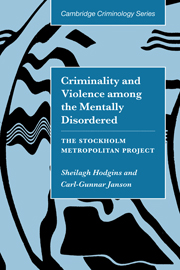Book contents
- Frontmatter
- Contents
- List of figures
- List of tables
- Preface
- Introduction
- Chapter 1 Research on the criminality and violence of the mentally ill
- Chapter 2 The longitudinal approach
- Chapter 3 Swedish society and Stockholm: the cohort and its context
- Chapter 4 Criminality
- Chapter 5 Explanations of the criminality of the mentally ill
- Chapter 6 Early and late-starters
- Chapter 7 Conclusion
- References
- Index
Chapter 7 - Conclusion
Published online by Cambridge University Press: 22 September 2009
- Frontmatter
- Contents
- List of figures
- List of tables
- Preface
- Introduction
- Chapter 1 Research on the criminality and violence of the mentally ill
- Chapter 2 The longitudinal approach
- Chapter 3 Swedish society and Stockholm: the cohort and its context
- Chapter 4 Criminality
- Chapter 5 Explanations of the criminality of the mentally ill
- Chapter 6 Early and late-starters
- Chapter 7 Conclusion
- References
- Index
Summary
Mental disorder and crime have been examined in a birth cohort of metropolitan Swedes born in 1953 and followed to 1983. A number of conclusions can be drawn from this experience. Initially, we assess the usefulness of longitudinal, prospective cohort studies such as the Metropolitan Project. Next, we review the principal results of our study of criminality among persons with major mental disorders. From these results, we draw a number of conclusions regarding the assessment and treatment of offenders with major mental disorders and future research on this issue.
THE METROPOLITAN PROJECT
Like any longitudinal, prospective study, the Metropolitan Project required considerable investment of time and money during a period that spanned more than thirty years. However, as the findings described in this book and a perusal of the publications from this project demonstrate, it has contributed to advancing knowledge on a wide variety of important issues.
Like longitudinal prospective investigation of this type has a number of advantages. One, an unbiased cohort is examined. However, like any cohort, it is a sample with special characteristics determined by place and time. As described in Chapter 3, the society in which the cohort members were raised had many unique characteristics which must be taken into account in interpreting the results.
- Type
- Chapter
- Information
- Criminality and Violence among the Mentally DisorderedThe Stockholm Metropolitan Project, pp. 180 - 198Publisher: Cambridge University PressPrint publication year: 2002

